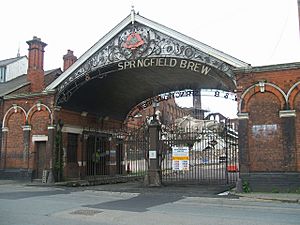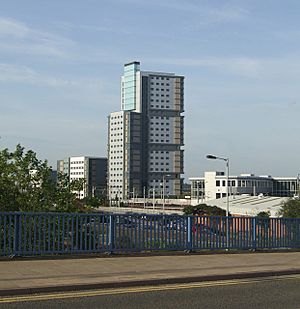Springfield, Wolverhampton facts for kids
Quick facts for kids Springfield |
|
|---|---|
| OS grid reference | SO921994 |
| Metropolitan borough | |
| Metropolitan county | |
| Region | |
| Country | England |
| Sovereign state | United Kingdom |
| Post town | Wolverhampton |
| Postcode district | WV10 0 |
| Dialling code | 01902 |
| Police | West Midlands |
| Fire | West Midlands |
| Ambulance | West Midlands |
| EU Parliament | West Midlands |
Springfield is a part of Wolverhampton, England. It is located just northeast of the city centre. This area was once home to the famous Springfield Brewery, which operated from 1873 to 1991. Today, the brewery site has been transformed by the University of Wolverhampton. It is now a special campus for architecture and building studies, including the National Brownfield Institute. Springfield also has modern buildings where university students live. One of these is the tallest building in Wolverhampton! For local government, Springfield is part of the Heath Town area.
Contents
Where is Springfield Located?
Springfield is separated from Wolverhampton city centre by a few important landmarks. These include the A4150 ring road (St Patricks), the Birmingham Canal Navigations Main Line, and two railway lines: the Wolverhampton–Shrewsbury and Rugby–Birmingham–Stafford lines.
The area is found between the A460 Cannock Road and the A4124 Wednesfield Road. To its east, Springfield borders Heath Town.
Springfield's Past
Wolverhampton Low Level railway station opened in 1854. After this, Springfield became one of the first areas east of the Oxford, Worcester & Wolverhampton railway line to be developed. By 1860, many terraced houses were built on streets like Culwell Street, Field Street, and Spring Street. Some of these streets later disappeared in the 1960s due to new building projects.
In 1878, Wolverhampton Council bought land in Springfield. They used a law called the Artisans' and Labourers' Dwellings Improvement Act 1875. This allowed them to plan 290 new houses with streets and sewers. These homes were for people who had to move from crowded areas in the town centre.
The Famous Springfield Brewery
The Springfield Brewery opened in 1873. The company, William Butler and Company, needed a bigger place than their old site. Springfield was chosen because it had lots of water from natural springs. Also, the land had not been built on yet, even though it was a bit marshy.
The company bought a seven-acre site and built a new brewery. It included places for making malt, repairing barrels, and stables for horses. Brewing started the next year. Because the new brewery was close to the canal and railway lines, the company could sell its beer far away. They even got their own railway siding!
The brewery grew bigger over time. Between 1881 and 1883, a new brewing tower was built. This helped them make much more beer, going from 400 to 1,500 barrels a week! One of their beers was even called Springfield Bitter.
In 1960, another company called Mitchell's and Butler's bought William Butler and Company. They kept the Springfield Brewery open until 1991, when brewing stopped. The main brewery building was given a special protection status that same year.
Sadly, in 2004 and 2005, fires badly damaged the main brewery building. It was left as an empty shell. There were plans to build homes there, but these were stopped in 2008. Finally, in 2014, the University of Wolverhampton and Wolverhampton City Council bought the site to rebuild it.
Joshua Bigwood Company
Joshua Bigwood was an electrical engineering company. It started in 1874 and had its main office and factory on Wednesfield Road. In 1965, another company took it over. Before it closed in 1986, the company made machines for shaping metal and equipment for burning fuel. It had about 85 employees. The old buildings have been pulled down, and new houses are now on the site.
Important Buildings and Places
Victoria Hall Student Homes
Victoria Hall is a place where students from the University of Wolverhampton live. It has four tall buildings. The tallest one has 25 floors and is about 77 metres (253 ft) high. When it was built in 2009, it was the tallest modular building in Europe.
Modular buildings are made from parts built in a factory and then put together on site. For Victoria Hall, 383 parts were made in Ireland. Each part had a steel frame, concrete floor, walls, ceiling, and even plumbing already installed! These parts were then put together above the ground floor. This tower is the tallest building in Wolverhampton. However, a taller modular building has since been built in Croydon.
University of Wolverhampton Springfield Campus
The University of Wolverhampton bought the 12-acre (4.9 ha) Springfield Brewery site in 2014. The buildings were old and falling apart. The first building to be fixed was the pumphouse near Grimstone Street.
A special college, the West Midlands Construction University Technical College, opened on the site in 2017. It was later renamed Thomas Telford University Technical College. A year later, The Elite Centre for Manufacturing Skills opened in the brewery's old stable blocks. The University's School of Architecture and Built Environment moved to Springfield in 2020.
The architects who designed the new campus kept much of the old brickwork. The brewery courtyard is now covered by a glass roof, making a bright atrium. The brewery tower has a new, lit-up glass box on top, replacing an old water tank. The clock on the tower is an exact copy of the one from 1922. The old gateway on Cambridge Street and the stable blocks around it have also been restored.
The National Brownfield Institute opened in September 2022. This institute studies how to reuse brownfield land. Brownfield land is old industrial land that needs cleaning up before it can be used again, often for housing. The institute has laboratories to test soil and drainage. One cool thing they have is Spot, a robotic dog from Boston Dynamics. Spot has scanners to check dangerous industrial land!
Homes in Springfield
Some older terraced houses can still be found on Hilton Street, Springfield Road, and Woden Road. There are also council-built homes from the 1920s on Burton Road. However, most houses in Springfield were built from the 1980s onwards.
Since 2000, old factory sites have been turned into new housing areas. For example, where the Chubb and Gunnebo factories once stood, you now find homes on Tumbler Grove and Charles Drive. The old brewery's maintenance yard is now Peterhill Close. Here, the original brick walls on Cambridge Road were kept, but made a bit shorter.
Schools in Springfield
Woden Primary School is located on Springfield Road. This site first opened as Hilton Street Board School. It was soon renamed Springfield Road School. In 1931, it became Springfield Road Senior Boys' School. A famous person who went to this school in the 1940s was Johnny Nicholls. He became a professional football player for West Bromwich Albion. The school later closed in 1974. The site reopened in 1977 as Woden Primary School.
Places to Worship
St Stephen the Martyr is a Church of England church. It is connected to St Stephen’s C of E Primary School on Woden Road. The church building is made of red brick and was built in 1907.
The New Testament Church of God, Harvest Temple, is in the old St Barnabas Church of England building on Wednesfield Road. This church started in Wolverhampton in 1953. It was the first New Testament Church of God in the United Kingdom. In 1996, the church bought a nearby pub called the Traveller's Rest. They renamed it New Trust Centre and use it for community support programs.
Getting Around Springfield
Bus Services
The main bus company in Springfield is National Express West Midlands.
If you travel east, most buses end their journey in Wolverhampton city centre. However, the number 2 bus continues to Penn Fields and Warstones.
If you travel west along Cannock Road, the number 2 bus goes to Bushbury Hill. The 11 goes to Underhill. The 70 goes to Cannock.
If you travel west along Wednesfield Road, the number 9 bus goes to Walsall. The 57 goes to Bilston. The 59 goes to Ashmore Park. The 65 goes to Fordhouses. The 69 goes to Walsall. The 71 goes to Cannock.
Train Services
Wolverhampton railway station is very close, just southwest of Springfield.
Future Plans
In July 2021, it was announced that the site of Wolverhampton Council's Culwell Street depot and office building will be redeveloped. Funding was secured in November 2022 to pull down the old buildings and clean up the site. This new development is part of a bigger project called Brewers Yard. Plans for the project were approved in July 2023.
Famous People from Springfield
Don Howe, a well-known footballer and football manager, was born in Springfield in 1935.




